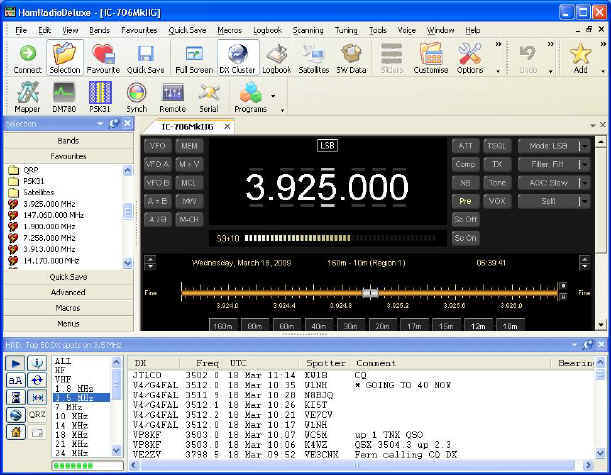EMF - electromagnetic field - is a physics term, one that amateur radio operators know about, perhaps not in those very words, but from their studies for licensing examinations they know that magnetism and current flow are related. A flow of electrons through a conductor creates a magnetic field that is strong in the vicinity of the conductor, but falls off rapidly as distance from the conductor increases. Even though we can't see an electromagnetic field, it is a real physical field produced by electrically charged objects, and we can measure it with various instruments. A simple one is a compass, the needle of which will move when it is in the vicinity of a conducting circuit hooked to a battery. This is a simple experiment done in elementary school science classes.
Both AC and DC produce EMF. Some devices, like your simple doorbell, depend on the magnetic field generated in a coil when a doorbell button closes a switch that allows current to flow. The magnetic field pushed an iron rod into a piece of tuned metal that makes the ding-dong sound. Some appliances around the home use motors that require much more energy to do work, such as running the compressor in your fridge or moving the fan blades in your furnace. The more current that flows, the stronger the EMF, most of which is contained within the motor and the appliance cabinet.
Ham radio equipment generates EMF, too, but much is at radio frequencies, as you would expect! There will be other electromagnetic fields around power supplies and other accessories. Even the desk lamp on the ham shack desk and the wiring inside the walls of the house have electromagnetic fields surrounding them.
In short, we are bathed in EMF from almost everywhere!
Now, with all of that in mind, let's look back a couple of weeks into the news. At the University of California in San Diego there is an ongoing flap over a cancer cluster in a single campus building. The gist of the story is that the Literature Building is suspected of having cancer-causing EMF because a larger than expected number of cancer cases have shown up among people who work or have worked in that building. I'll give you the link to the story on the campus newspaper website after this story, but for now, let's look a little more closely at what has happened at the campus.
The facts are these:
- There are electromagnetic fields in the UC Literature Building, as there are in every campus building.
- There are elevators in the building, and the motors that run them generate electromagnetic fields.
- A number of workers in the building have indeed been diagnosed with cancers of various types over a period of years.
- There is a cluster of cancer cases, given the way one maps out the parameters over time and space.
- The issue is an emotional one that has generated demonstrations, marches, and anti-EMF activism among faculty and students.
But what do you think? As ham radio operators, we certainly have an interest in a story like this!
Should we be worried that EMF will give us cancer? It sure seems that some of the students and faculty members at the University are worried enough to take action, even to the point of demanding that the entire building undergo a renovation.
Well, here is what I think: Sometimes people get an idea into their heads and even though it is not strongly supported by empirical evidence, the kind of evidence that good science demands, they still believe that they are right. Something like EMF is a good candidate to pin an otherwise unexplainable cluster of cancer cases upon, especially since it is invisible and possibly mysterious to those who are not educated in the sciences. Remember, mankind has a long and sad history of blaming natural events on something like the position of the planets in the sky! Malaria was once thought to be brought on by swamp air. Gemstones had the power to protect you against diseases; emerald protected the eyes. Disease and causality were simply not understood, and the germs that caused many diseases were invisible, just like EMF.
Today, people still fall prey to the same mistake of associating two independent events and assuming that one causes the other.
Now, I am not going to say that EMF in extremely high concentrations or over long periods of time is perfectly safe. I am also not convinced that the cancer cluster in the Literature Building has anything to do with EMF. Did the two exist together? Yes. Are they connected? Maybe, but maybe not.
Cancer clusters are little understood by laymen, and even educated residents of a college campus can make mistakes interpreting what seem to be straightforward facts. After all, the thinking goes, there were many more cancer cases in the Literature building than one might expect by sheer chance. Something caused them, so it must have been EMF, because it acts in mysterious ways, not fully understood, upon the body.
The problem is that cancer clusters are not necessarily a statistical anomaly at all. Try this: Think of a grid of 100 squares, such as a perfectly flat tile floor in your kitchen. Now you pour an entire jar of 100 marbles out onto the floor from as high as you can reach. The marbles will bounce around at random and eventually come to a standstill, distributed across the entire kitchen floor. Look at each square tile. Does each tile have exactly the same number of marbles on it? Not likely! Some tiles will have none, most perhaps one or two, and one tile may have a half dozen. Now, imagine that the tile with a half dozen marbles is the Literature building. What "caused" the marbles to stop in that particular tile? After all, the average number of marbles on a tile is only one. Something must have "caused" the marbles to concentrate there, right?
Wrong.
Pure, random chance is in play here. Nothing "caused" the concentration of marbles on that particular tile, just as a tile with no marbles was not "protected" from marbles by some unseen force. So cancer clusters can be random. The fact that there are electromagnetic fields present in the Literature Building may be no more relevant than the color the walls in the Literature building are painted. It would be astounding if your 100 marbles distributed themselves exactly one per tile on the kitchen floor, and so it is with real life geographic distributions.
It is easy to be tricked by this phenomenon. Our minds work to seek out cause and effect. We want to know a reason why things are as they are, but every cluster does not mean there is a cause related to anything other than chance.
As an amateur radio operator, I know that electromagnetic fields are generated by my equipment. Some of these are proven dangerous, such as high power, concentrated microwave energy. But I am not going to worry about the EMF from my refrigerator or an elevator motor. I am going to take prudent steps to reduce RF exposure. I don't worry about getting cancer from a cell phone or handheld radio, but I do wear a seatbelt when in an automobile and hold the railing while using the escalator or taking the stairs. Ham radio isn't going to give you cancer, but you could fall off the tower while putting up an antenna. Take stock of reasonable risks and prepare for them. Use a safety belt and hard hat when doing tower work. And enjoy getting on the air.
I don't want to dismiss the very real concerns of the UC San Diego students and staff, but I do think that it does not serve a useful purpose to fixate on electromagnetic fields as "the cause" of a cluster of cancers. It will be interesting to follow this story as it unfolds. I prefer to be open-minded. If empirical evidence exists outside of random chance, it is important for us to learn about any effects electromagnetic fields have on the body.
Now, as I promised, here are some links you can use for further reading:
 Free software tour: Two screenreaders
Free software tour: Two screenreaders Free software tour: Ham Radio Deluxe
Free software tour: Ham Radio Deluxe It has been a relentless winter here in the Northern Hemisphere, so I thought it would be nice if we all took a bit of a holiday. I can't afford a real holiday, but how about a tour? A virtual tour of some of the best free software I have discovered over the years might be just the thing to help us make the last dregs of winter go down a little easier!
It has been a relentless winter here in the Northern Hemisphere, so I thought it would be nice if we all took a bit of a holiday. I can't afford a real holiday, but how about a tour? A virtual tour of some of the best free software I have discovered over the years might be just the thing to help us make the last dregs of winter go down a little easier! EMF - Run for the hills, it'll get you!
EMF - Run for the hills, it'll get you!